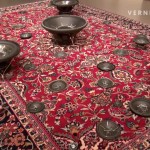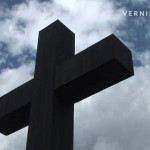Triple Take at Wilde Gallery Basel is a group exhibition that addresses surreal moments in domestic spaces, feelings of ambiguity, time suspended and a need to escape. Triple Take features works by the artists Per Barclay, Valentin Carron, Mathieu Dafflon, Arguiñe Escandón, Jan Fabre, Mounir Fatmi, Philippe Favier, Vidya Gastaldon, Florian Graf, Yann Gross, Patricia Kaliczka, Kaspar Ludwig, Rachel Lumsden, Lou Masduraud, Andrea Mastrovito, Fabien Mérelle, Timo Paris, Léopold Rabus, Michael Ray-Von, Antoine Roegiers, Dorian Sari, Cassidy Toner and Not Vital.
The exhibition draws its title from the third year of the pandemic: “Triple Take ventures to capture the zeitgeist of the past few years. Now in the third year of the pandemic, no one could have anticipated how their lives would be upended. For the first time since it began, Basel will again be able to celebrate Fasnacht, the city’s pride and joy, a moment of scaring away the winter, donning a mask, and escaping into the surreal world that is the carnival. Domestic spaces also took on another life, serving as guarded refuges and circumspect sanctuaries.”
Triple Take / Group Exhibition at Wilde Gallery Basel. Vernissage, February 20, 2022.
> Right-click (Mac: ctrl-click) this link to download Quicktime video file.
Exhibition text (excerpt):
Entering the gallery, one encounters Jan Fabre’s Devil Mask (2002). The gold-coated sculpture is shaped like a human sacrum, which in Prehispanic Mesoamerica was considered the “sacred bone,” representing a portal or doorway permitting the translocation of shamans, spirits, and deities between worlds or dimensions of the cosmos. The work echoes the tradition of these communities using animal pelvises to form ceremonial masks. This need to escape our realities is perhaps unique to our species and was documented by Yann Gross and Arguiñe Escandón during their travels to the Peruvian Amazon. There they photographed shamans performing indigenous Ayahuasca rituals. The other image depicts a young woman holding a native Aloe Vera over her face as a mask. In the work of Antoine Roegiers, a film adapted from the painting Squelette arrêtant masques (1891) by James Ensor, a partially-masked skeleton in a red coat stands behind a masked woman, as she dances with another skeleton, giving the macabre subjects an air of festivity.
This notion of escaping from our domestic realities is particularly compelling in the work of Lou Masduraud, which comprises four air vents located in different rooms around the gallery, serving as psychological and physical portals. One such work, a black-and-red-glazed ceramic sculpture, appears to have been pried open as if someone were trying to enter or exit. Adjacent to it, a work of Per Barclay features a frame with a protruding steel staircase, evoking a passage. And on the opposite wall, Open Door (Berlin), 2011 by Florian Graf depicts just this.
Two large paintings by Léopold Rabus, Pêche en Haute Savoie, 2017 and Poules avec guirlande, 2022 teeter on the boundaries of fantasy and reality. One, featuring a nearly empty room, shows wooden floorboards, with light coming from above and a perspective that seems both impossible and disorienting. Rabus’s large-scale painting of chickens, these flightless birds, echoes this need to escape but being unable to. Trapped as domesticated and farmed animals, their future already predetermined.
In contrast, the third room on the ground floor features some hope to actually escape, to take a Time Out, as is written on the painting by Florian Graf reminiscent of Ruscha-esc sign-painting or billboard, advertising some solution to feeling mentally entangled. Two portraits, one by Patricia Kaliczka with a bird on her head, pecks at her third eye, threatening her enlightenment perhaps, while the second by Fabien Mérelle portrays him perilously atop a tree. Do they long for the freedom birds symbolize? The painting Arboretum 2, 2021, by Rachel Lumsden recalls a lush garden teeming with birds. A coming of spring, of winter, finally giving way. Finally, the watering can, Lucky Loop (2021), by Florian Graf waters itself, conceivably a form of self-care, of tending to a garden which in return tends to the well-being of its caretaker.
Per Barclay challenges such a need for escapism. In his work, Conversations (1997-2006), three aluminum skulls face each other, with pairs of metal zils placed where their eyes, ears, and mouth would be. They symbolize the three wise monkeys, who “see no evil, hear no evil, speak no evil,” which is how we collectively behave in Barclay’s opinion, ignoring the degradation of the climate and inequality of wealth. Similarly, Valentin Carron’s work, Ovals in the Dark XII (2022), depicts two masked faces floating in an empty abyss, unable to communicate. As Mounir Fatmi’s work, Everything is Connected (2018), illustrates, such a desire is futile. Our lives are intertwined, to each other, to our environment, and to the technologies we invent. Vidya Gastaldon’s work is engrained in this idea. For her, cosmic representations give the appearance of a larger, complex ecosystem. She considers herself a vessel, painting wonderous worlds in which nature would have a magical force.
Space and how we exist within it is the forefront of the works by Timo Paris, Michael Ray-Von, and Cassidy Toner. This Triple Take, they intervened with the gallery’s architecture and various rooms. Paris has created two site-specific installations that aim to promote a dialogue between the experiencing self, shaped by physical experience, and the narrative self, which is often strongly influenced by our visual perception. The work of Michael Ray-Von is concerned with illuminating elements of exhibition spaces that otherwise go unnoticed. For this installation in the gallery’s kitchen, Ray-Von has projected a film featuring a dialogue generated by a neural network that he fine- tuned with screenplays collected from seven of director David Cronenberg’s most notorious films from his body-horror period. These films thematically explore post-human fantasy, cyborg ontology, hallucination, disorientation, and often present objects which are not strictly non-living.
Finally, roaming around the floor are mobile objects Cassidy Toner refers to as Dust Bunnies. They are “battery-driven and faux fur clad balls that hurtle into surfaces before shooting off, picking up dirt,” acting as a “sponge for Toner’s habits of consumption, analogizing, as Toner puts it, ‘how life mixes together,’1 a fact that we will never be able to escape.













